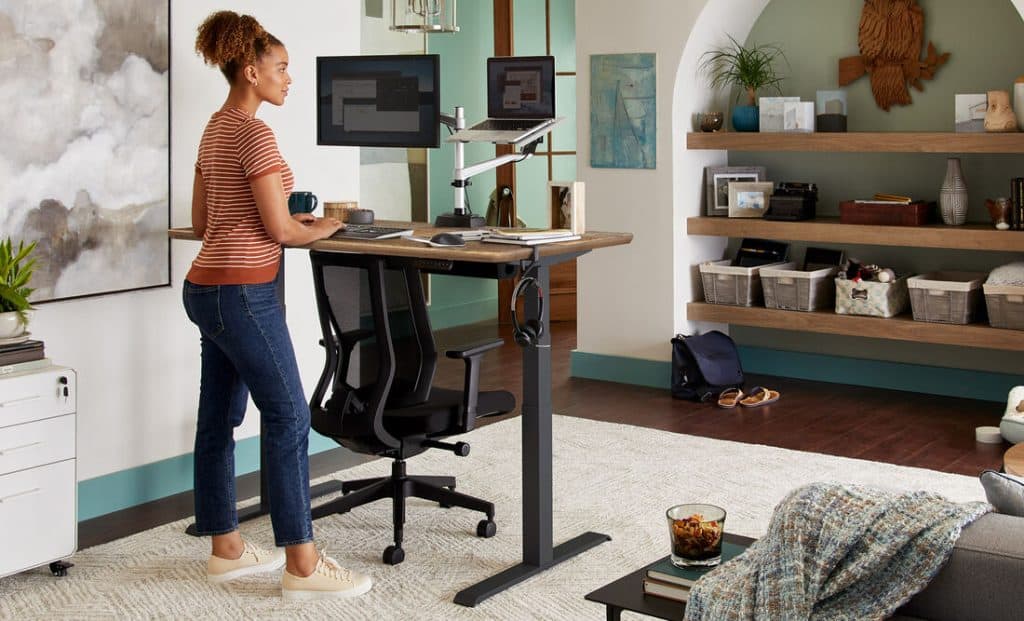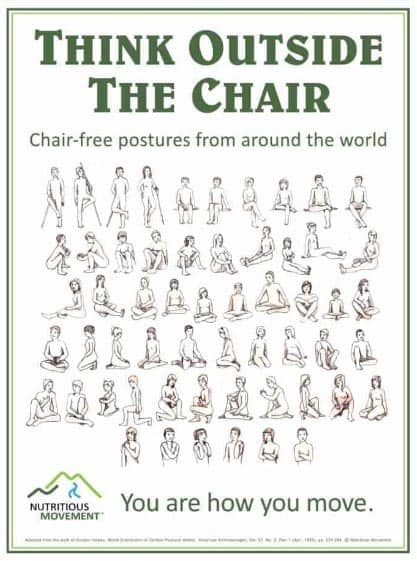Quick & Proven TRS Strategies That Work: How To Relieve Lower Back Pain
Back pain is, well, a real freaking pain. And a common one, at that. Some studies say 23% of adults suffer from low back pain, and other estimates range as high as 84% over a lifetime.
So what gives? (Other than your back, apparently.) If we’re supposed to live 7 to 10 decades on this earth, why would the spinal engine be designed so poorly?
That’s the thing–it isn’t. Our spines are built to last us a lifetime, but they aren’t designed to be crammed into one position for hours a day, days on end, weeks upon weeks, and on-and-on.
I’m talking about sitting, of course.
Chairs have jacked up our backs and bodies. Tribal men have been observed to be extremely indolent, but they don’t sit for hours in the hunched, office-chair position. They change position, lie down completely, walk casually, and whatnot.
In fact, their backs appear fine enough. Consider the notably fit physique of even elderly members of hunter-gatherer societies, such as the Hadza.
So contrary to popular belief, it was actually not easy to jack up your spine. It’s a robust and adaptable system. Here at The Ready State, we believe in the human body’s innate ability to heal.
You’re not doomed to your pain. By using simple techniques, you could quickly relieve pain and restore proper functioning even in the most achy backs.
Understanding How Your Back Pain Started
Finding relief for back pain means understanding what went wrong in the first place. Your back isn’t as fragile as you think, and it shouldn’t bear all the blame.
Your spine is a foundation for your musculoskeletal system. It’s stable, protects your nervous system, and can flex and bear weight.
The fundamental reason why so many people experience chronic back pain is due to your spine’s lack of variety and movement. But even the active among us often sit in an office chair for 8 hours a day.
In research performed by Dr. Joan Vernikos for NASA, it was observed that stagnation, staying in the same position for long periods of time, came with a myriad of health consequences. It can lead to blood pressure fluctuations, decreased heart function, and skeletal dysfunction, among other implications.
Good news: You can deter these health effects by simply changing posture every half hour or so. After all, we didn’t always have chairs. Chairs are Western inventions that only became commonplace in the last century. Have you ever tried sitting on the floor or working at a standing desk station? You may have noticed how often you naturally change posture to relieve discomfort.
Removing the chair elements, the same postural change we need is built into our movement world. Let’s go over it in more detail in the following part.
3 Ways To Relieve Lower Back Pain
Your back is meant to last a lifetime, but it won’t if you sit in the same hunched position all day. To restore it’s innate stable positions, you can incorporate the varied postural changes of your ancestors. Here are a few ways to do exactly that:
1. Change Posture Every Half Hour
Dr. Vernikos believes that altering posture every half hour can entirely neutralize the health implications of chronic stagnation.
It’s also important to know that an hour of exercise per day can’t negate the effects or consequences of sitting all day.
We can interpret this two ways:
- Postural changes are the key, not exercise intensity.
- Breaking stagnation regularly rather than working out works best when dealing with pain.
So, it’s best to set a timer on your phone during work hours (or any long periods of sitting or standing) and change your posture.
At a minimum, stand up and then sit back down. Yep. You don’t even have to do anything else. Just stand up every half hour, even if you just sit down again.
Rather than just stand up every 30 minutes, why not do something that could help rehab your back at the same time?
For example:
- Mobilize every hour: Do a 2 minute mobilization from The Ready State.
- Grease-The-Groove: Popularized by Russian Strength Training Coach Pavel Tsatsouline, do 5 reps of any exercise every hour (pullups, pushups, squats, whatever. You could alternate every 30 minutes between doing a mobilization or doing 5 reps of an exercise).
- Build A Habit: Walk for 10 minutes every 2 hours.
The world is your playground here. Just don’t get caught up trying to figure out the best thing and end up not doing anything.
2. De-bone Your QL
The quadratus lumborum is the lumbar spine’s deep muscles. They can become notoriously stiff in athletes and non-athletes alike. Chronic sitting aggravates it, and it can become so stiff that they feel more akin to bones than soft tissues.
To counter it, the TRS QL smash mobilization uses a lacrosse ball or larger ball like The Ready State Supernova. It’s one of the fastest ways to relieve back pain (and it also feels freaking great.)
De-boning your QL is a game-changing mobilization for your back pain. Follow this for fast relief, relaxation, downregulation of the nervous system.
3. Upgrade: The Four Horsemen of The Spine
Go beyond the QL by addressing the four major tissues most affected by chronic sitting. These so-called “four horsemen of the spine” are the Rectus Femoris muscles which connect the knee to the hip, the QL, the Iliacus, and the Psoas muscles of the iliopsoas region of the lower abdomen.
These muscles all connect the hip to other parts of the body (and spine). Stiffness in any of them can be a major culprit in back (and knee) pain.
If you’ve got 30 minutes, a foam roller and a ball, I strongly recommend giving the four horsemen routine a try. Incorporate this routine at least once a week alongside the other tools here:
Bonus: Increase Movement (& Upgrade Your Work Station)
We’ve addressed the origin of the problem by incorporating postural changes. Then we gave you a tool for relieving your pain using tissue mobilizations. Now it’s time to move.
More often than not, pain is simply a matter of not moving enough.
This is why a staple component of nearly every one of The Ready State Pain Protocols is to increase your daily step count. Go for a walk upon waking, before bed, and if possible, during your lunch break.
Ideally aim for 10,000 steps a day or more. Walking can utterly transform your health and your pain, as I expound on here.
Don’t have time? Upgrade your workstation. Treadmill workstations are an incredible tool for pain. They’re a step up from simple standing desks or getting rid of your chair and moving things to the floor.
The Varidesk Laptop Stand is my go-to tool as you can place it on most regular desks to create a standing workstation. It’s also the perfect height for sitting on the floor.
Don’t feel flexible enough for floor sitting? Get a couple cheap yoga blocks off amazon and voila: a world of possibility close to the earth. For a full guide to the magic of floor sitting check out this article.
Helping Your Lower Back Pain: Sit or Lay Down, Muscle or Disc, and When to Seek Help
Now that you know how to relieve low back pain, let’s address some common questions about it. Understanding what to do and where it hurts when the jolt strikes can help ease the pain safely.
Is It Better To Sit Or Lay Down With Lower Back Pain?
The answer isn’t a one-size-fits-all, as everyone’s preferences and pain are different. Here are some handy pointers to help you find your go-to position.
- Sitting. Sit with proper posture, keeping your upper body upright and aligned. Place your feet flat on the floor and maintain a 90-degree angle at your hips and knees. For added support, consider using a cushion or lumbar roll to relieve strain on the spine and regulate your blood flow.
- Lying Down. This position can help promote muscle relaxation. Choose a firm mattress or lay on the floor with a thin cushion or heating pad for comfort. You can also place a pillow between your knees to keep your spine’s natural curve.
Listen to your body. Some individuals find relief through sitting, while others prefer lying down. So go ahead, experiment, and discover what works best for you.
Is It A Muscle Issue Or Something To Do With The Discs?
Differentiating between muscle-related and disc-related lower back pain can be a bit tricky, but we’ve got your back (pun not intended). We’ve seen enough cases to know what signs and indicators to look out for.
- Muscle-Related Pain. It’s a muscle spasm/strain if it’s a localized pain that worsens with movement. You’ll feel some soreness or stiffness in the afflicted area. It may improve with rest, gentle stretching and time.
- Disc-Related Pain. Spine discs herniate or degenerate, compressing your nerves and causing radiating pain. It often travels down the leg and may be accompanied by numbness, tingling, or weakness. Bending or extended sitting can aggravate this back pain; lying down reduces it temporarily.
In any case, consult with a physical therapist or orthopedic specialist to pinpoint the source of your back pain. Only with a specific diagnosis can you find the best treatment options.
How Do I Know If My Back Pain Is Serious?
Most cases of lower back pain don’t require immediate medical attention. However, if you see any of these red flags, don’t delay seeking expert help. Prompt diagnosis and treatment are crucial for addressing potential serious underlying conditions.
- Severe and persistent pain that worsens over time
- Pain accompanied by bladder or bowel dysfunction
- Numbness/weakness in the legs, feet, or groin area
- Loss of coordination or difficulty walking
- Unexplained weight loss, fever, or night sweats
- History of recent trauma (e.g., fall or accident)
Don’t take any chances when it comes to back pain. Know how to deal with it, make time for physical therapy, maintain a healthy weight, and employ TRS pain relief measures, —your back will thank you.
Beyond Relief with TRS
The simple tools here are great for not only getting relief from back pain. They also order your environment to prevent pain in the future. With that said, they are but a taste of the many options available.
Our bodies are a contiguous tissue system, meaning that your pain may not be a result of the most obvious tissues. Your origin point could have more to do with the musculature of your necks and traps than your hips, or your gait while walking might be contributing to your back pain.
Tools like the H-Wave E-Stim device or alterations to your exercise routines could be helpful.
You can also check out resources like our advanced Pain Protocols. You can also peruse the members’ areas like the pain sections or daily maintenance routines.
Do you want to further understand the inner workings of back pain? Are you looking to become a movement and mobility specialist? The Ready State can help.




















TRS Virtual Mobility Coach
Guided mobilization videos customized for your body and lifestyle.
FREE 7-Day Trial